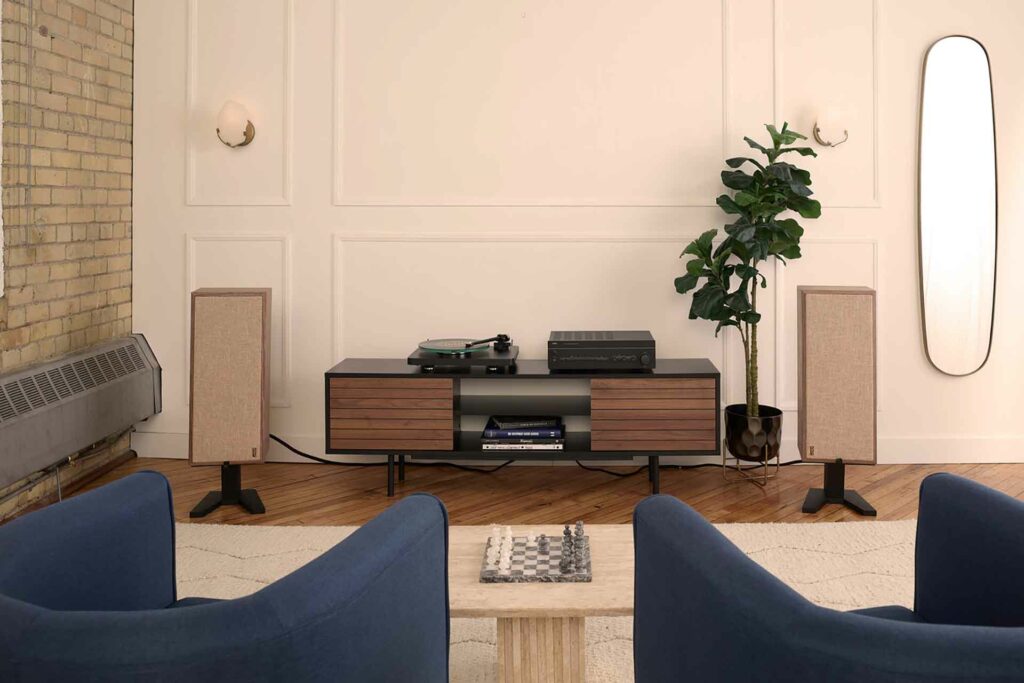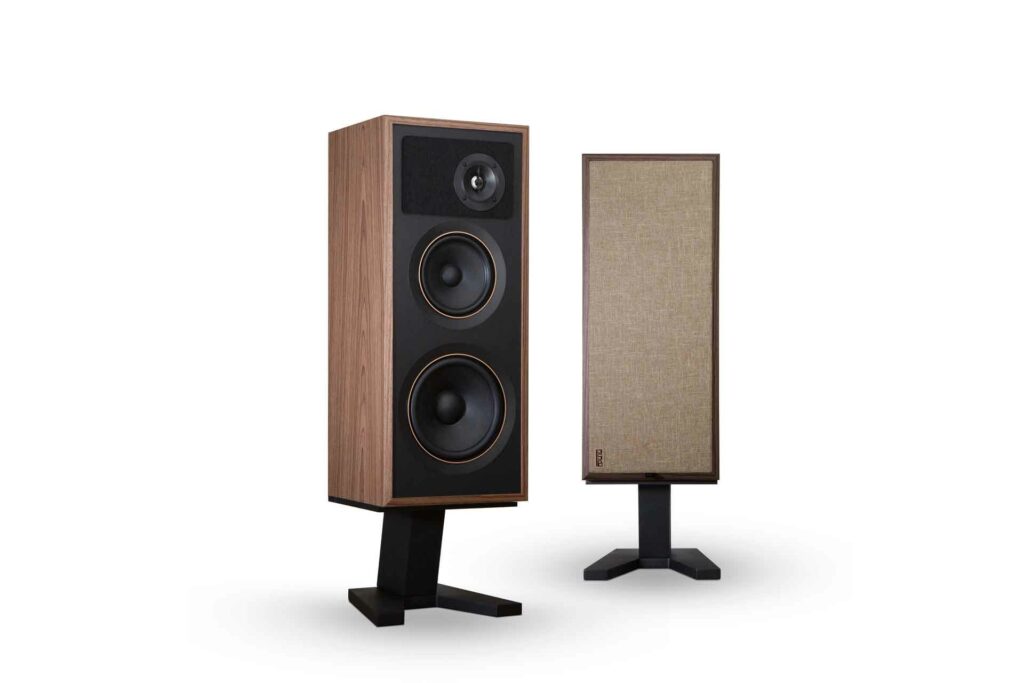PSB was founded in 1972 by Paul Barton, a designer who believed speakers should sound natural without adding or subtracting anything from the original recording, which the company refers to as the True to Nature design philosophy. Equally important for the founder was to create affordable products so anyone could afford them.
The PSB Passif 50 stand-mount loudspeaker reviewed here is a $2,499 per pair throwback speaker, a tribute of sorts to the original PSB Passif II model produced in the 1970s. PSB isn’t the first to go retro with their speakers, and retro audio is very popular with a certain demographic of audiophile. JBL’s L-100s were a redesigned version of the classic speakers from that iconic Maxell cassette tape ad with the Le Corbusier chair and the hirsute dude being blown away by the sound. Various companies reproduce the BBC’s design for a nearfield monitor called the LS3/5a, including the recently reviewed Sound Artist version. PSB Passif II harkens back to speakers of the past like the AR 3A product, which were large and somewhat full range but not really floorstanding speakers as they use a small but notable stand. Let’s see if PSB’s legacy is well reflected in this new version.

What Makes the PSB Passif 50 Loudspeakers Special?
- The PSB Passif 50 is reincarnated from its original design, giving it a retro exterior with modernized componentry and cabinet design. With 50 years of loudspeaker knowledge and experience, which flows down from the company’s flagship Synchrony line, the only vintage characteristic of this speaker is its carefully curated appearance.
- Regardless of its design heritage, the Passif 50 succeeds at holding its own amongst other speakers at its price point.
- PSB speakers have for years been built on research performed at Canada’s National Research Council (NRC), which provides access to an anechoic chamber and electronic modeling, allowing real-time analysis of how changes in cabinet design, driver type, and layout impact audio acoustics.
- The Passif 50 is offered in a satin real wood walnut veneer with an intentional open-pore finish that you can actually feel. The cabinet sides and top create a beveled front frame that fits flush around the modernized magnetically attached grills. It is a nice touch at this price point and reminiscent of the older original design.
- The Passif 50’s two-way design incorporates a one-inch tweeter and 6.5-iunch mid-bass woofer along with a front-firing eight-inch passive radiator. The tweeter uses a titanium dome, a higher-powered neodymium magnet, and a ferrofluid for dampening, providing greater output and power handling while reducing distortion. It is surrounded by a relatively large felt pad that helps minimize diffraction. The woofer and passive radiator both use cast aluminum baskets for rigidity, with a flexible rubber surround.
- The speakers are shipped as a mirrored pair, meaning there is a specific left and right speaker, indicated by the inner location of the tweeter.
Why Should You Care About the PSB Passif 50 Loudspeakers?
- It’s a modern take on a classic PSB speaker design, offering renaissance aesthetics that can fit in both traditional and contemporary settings alike.
- The PSB Passif 50 has a long history and a legacy from an established speaker company that cares about sound quality and goes to extensive lengths to make a speaker sound natural without changing the character of the original recording.
- The PSB Passif 50 is a limited-run production that will last during the anniversary year. When they’re gone, they’re gone.

Some Things You Might Not Like About the PSB Passif 50 Loudspeakers
- While I appreciate the legacy form-factor of the Passif 50, some consumers may not.This is a personal decision where there is no wrong or right.
- PSB refers to the Passif 50 as a stand-mount loudspeaker but it is a hefty one. It requires the included short stands that not only elevate the height but also slightly lean back the speaker’s stance. The included speaker stands, while nice, are not the heaviest; therefore, the Passif 50 tends to be top-heavy. Also, the included carpet spikes are a bit short and could benefit from a bit more length, but this can be inexpensively remedied.
- With reported low-frequnecy extension of 50Hz, the Passif 50 might need to be paired with a subwoofer depending on your tastes in music. For most music, the speakers sound fantastic, but if you are a metalhead and like to play it loud, the lower frequencies are short of very deep bass.
- The Passif 50 is for two-channel music listening with no supporting center and surround speakers for home theater applications.
Listening To the PSB Passif 50 Loudspeakers
All of my musical selections for this review were streamed through Tidal by way of a NAD C700 Streaming Amp (buy at Crutchfield).
For the 1980s rock music we love that possesses recording qualities that we don’t, Fleetwood Mac’s “Gypsy” from their Mirage album is an excellent example of how the Passif 50’s was still able to produce a wall of sound more significant than one would expect. Stevie Nicks’ voice was silky smooth yet maintained texture while conveying her lamb-like vibrato. Imaging was excellent, with a broad and deep soundstage, and accurate band placement. I especially appreciated the not-too-forward nor too-laid-back presentation.
On Adele’s album 30, the song “Oh My God” is a modern recording that is somewhat atypical for the artist, as it has a trendy rhythmic flare that once again displayed a large, fantastic image via the PSBs. Nothing is out of place from the higher to the lower frequencies, with a natural layering of instruments and Adele’s voice in front. A true success, since there was no attenuation in any frequency range but rather a neutral tonal balance, allowing the track to play as it was intended. AC/DC’s “Thunderstruck” “Thunderstruck,” from their Razors Edge album, is a great torture test for bas, making the PSB Passif 50 struggle. This is an extreme demonstration as the bass line must be in the 30 Hz region, if not lower. In 90 percent of what I listen to, the Passif 50 would play well, but on a track like this, it gives the speaker a workout. If this genre of music is your mainstay, plan on adding a subwoofer or going another direction.
Do the PSB Passif 50 Speakers Hold Their Value?
PSB is a name-brand speaker company within audiophile circles that has been around for some time and has a bright future. This is not a fleeting, risky, unknown company but a recognizable brand that audio enthusiasts in the know will recognize. Also, while $2,500 per pair is not cheap, these are not ultra-expensive speakers, so they have a shorter distance to fall in terms of value. Given that the Passif 50 is a limited-run product, they may hold additional resale value compared to a speaker with a longer shelf life.

Who Is the Competition for the PSB Passif 50?
The Passif 50 speakers play at a compelling price point where competition is rampant. The entire audiophile speaker industry is flush with fantastic speakers in this general budget range. However, the Passive 50’s manage to impress with their sizeable natural presentation yet relatively diminutive size (relative, of course, to much larger floor-standers). The following speakers come to mind as alternatives worth looking at, though.
The Vandersteen Model 1C+ has been in production since the 1980s and has been updated along the way. I mention this speaker for this reason, and for being at a similar price point of $1,887. The Model 1C+ is a great starter speaker and will play into the lower bass with good imaging. It may have a smaller presentation, without the panache of the Passif 50, but if head-banging heavy metal or more bass-heavy hip-hop/rap music is in your repertoire, you may want to give these speakers a listen as they do a lot well in many musical genres.
Nothing could be more different from the Passif 50 than the MartinLogan Electro Motion ESL (buy at Crutchfield) recently reviewed by Jerry Del Colliano. So why am I bringing them up? Mainly for Price – at $2,800, the MartinLogan ESLs are just $300 more than the PSB Passif 50’s. As a hybrid electrostatic speaker, the appearance and technology are wildly different, but they too are iconic and beloved speakers in this category. The MartinLogan ESL may offer up a different type of sound, but nonetheless, at this price point, you may want to give them a listen. And while MartinLogan’s form factor is unique, they are definitely distinctive.

Final Thoughts on the PSB Passif 50 Loudspeakers
The PSB Passif 50 allows us to reflect upon the past while enjoying the present with a fresh technological take on a vintage design. The PSB Passif 50s sound large, image well, and are true to their goal by not altering the character of the original recording in any meaningful way.
I thoroughly enjoyed by time listening to the PSB Passif 50s, which often got me in trouble as I began exploring beloved older songs and artists, digressing from the task at hand while cranking the volume up and up. If you have a taste for vintage audio but don’t want to deal with vintage technology, these speakers perform fantastically, are not hard to drive, and have that retro-appeal that many are looking for today.




Reminds me of the 2nd generation Polk speakers(long forgotten) with the passive radiators that made them look like 3 ways(and Polk used the term fluid coupled driver to confuse the subject). I think reviews with passive radiators should make it clear that it’s not a driver but it’s a port substitute.
I agree
For me, it harkens back to the 1960s designs like the AR3A.